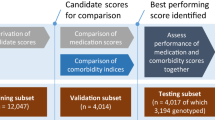Abstract
The pharmacy-based cost group (PCG) model uses medication prescribed to individuals in a base-year as marker for chronic conditions which are employed to adjust capitation payments to their health plans in the subsequent year. Although the PCG model enhances predictive performance, possibilities for gaming may arise as it is based on prior utilization. This study investigates several strategies to mitigate this problem. The best strategies appear to be: use a (high) number of prescribed daily doses to assign persons to PCGs, do not allow for comorbidity, and remove PCGs with low future costs. This PCG model accounts for almost twice as much variance as do demographic models. In 2002 the Dutch government implemented this model in the sickness fund sector (twothirds of the population).
Similar content being viewed by others
Author information
Authors and Affiliations
Additional information
Leida M. Lamers Department of Health Policy and Management, University Medical Center, Rotterdam, Erasmus MC, P. O. Box 1738, 3000 DR Rotterdam, The Netherlands, e-mail: Lamers@bmg.eur.nl
Rights and permissions
About this article
Cite this article
Lamers, L., Vliet, R. Health-based risk adjustment Improving the pharmacy-based cost group . Eur J Health Econom 4, 107–114 (2003). https://doi.org/10.1007/s10198-002-0159-9
Issue Date:
DOI: https://doi.org/10.1007/s10198-002-0159-9




